Sonova USA RICR Wireless Hearing Aid User Manual User Guide Audeo V R
Phonak Inc Wireless Hearing Aid User Guide Audeo V R
UserManual
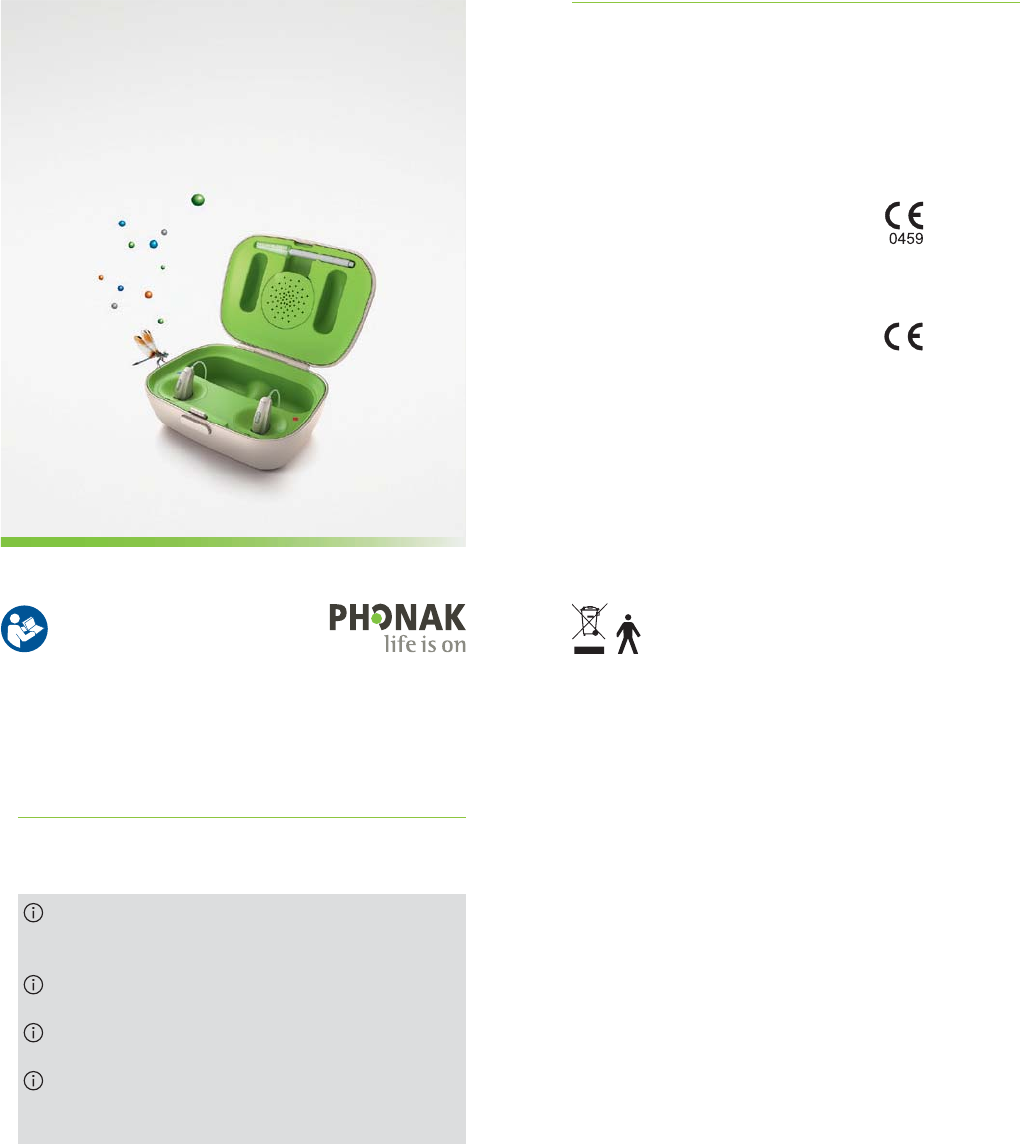
User Guide
(V90)
Phonak AudéoTM V-R
2
Wireless hearing aid
Phonak Audéo V90-R
Non wireless charging accessories
Phonak Charger Case
Phonak Power Pack
Phonak Mini Charger
2016
2016
2016
2016
This user guide is valid for:
3
Your hearing aid & charger details
Hearing aid model Earpieces
F Audéo V90-R F Dome
F SlimTip
F cShell
Charging accessories
F Charger Case incl. power supply
F Power Pack
F Mini Charger incl. power supply
If no box is checked and you do not know the
model of your hearing aid or charging accessories,
please ask your hearing care professional.
Audéo V-R contains a built-in and non-removable
rechargeable lithium-ion battery.
Please also read safety information regarding
handling rechargeable hearing aids (chapter 16).
Please ensure to charge and use the hearing aid
within operating temperature range: 0° to +40°
Celsius (33° to 104° Fahrenheit)
Your hearing aids and chargers have been developed by
Phonak – the world leader in hearing solutions based in
Zurich, Switzerland.
These premium products are the result of decades of
research and expertise and are designed to keep you
connected to the beauty of sound! We thank you for
making such a great choice and wish you many years of
listening pleasure.
Please read the user guide carefully to make sure that you
understand and get the best out of your hearing aids. For
more information about features and benets, simply
contact your hearing care professional.
Phonak - life is on
www.phonak.com
4
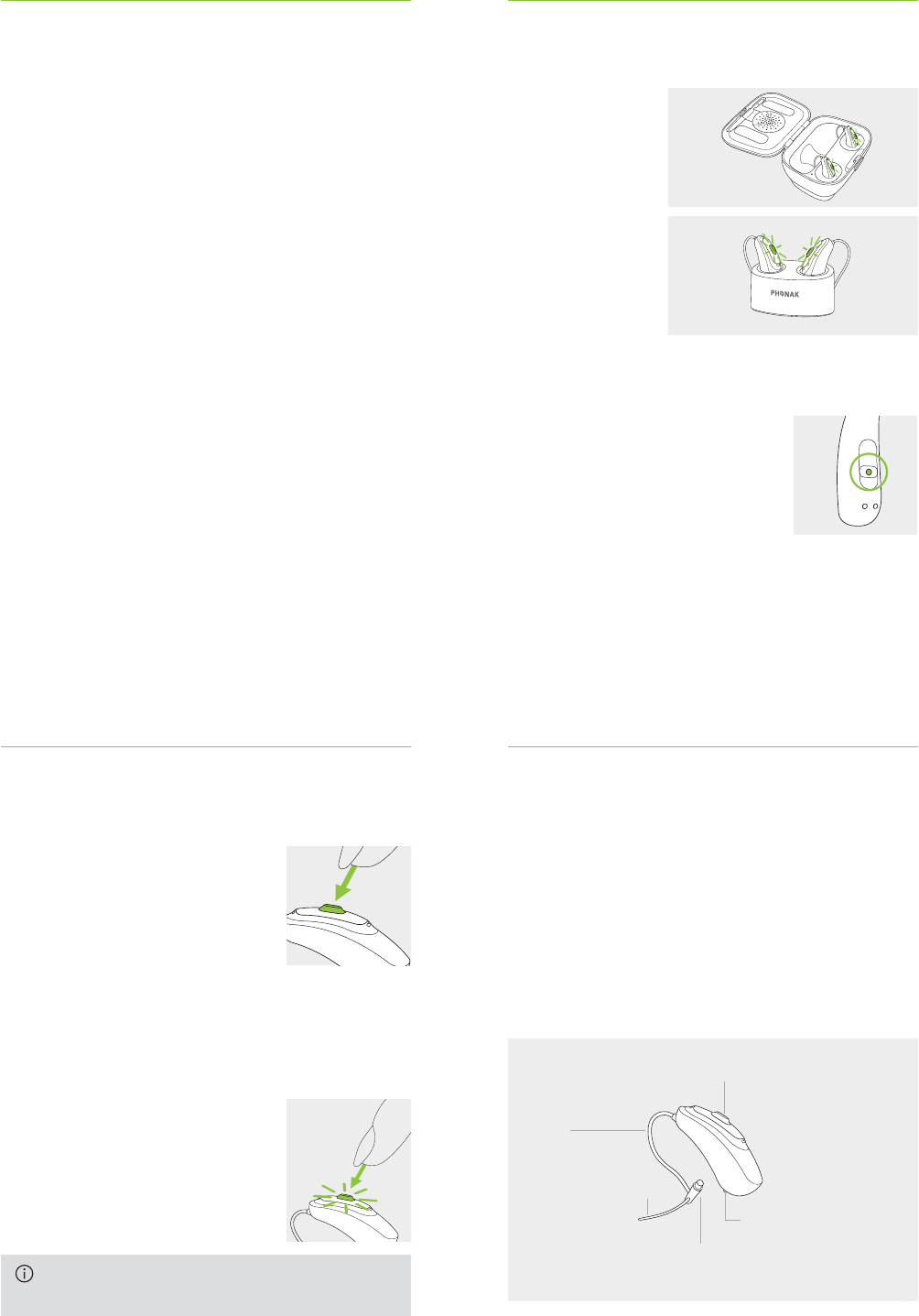
5
Contents
Your hearing aid and charger
1. Quick guide
2. Parts of the hearing aid & charger
Using the charger
3. Preparing the charger
4. Charging the hearing aids
Using the hearing aid
5. Left & right hearing aid markings
6. Push button
7. On/O
8. Putting on the hearing aid
9. Removing the hearing aid
Further information
10. Care and maintenance
11. Wireless accessories
12. Service and warranty
13. Compliance information
14. Information and description of symbols
15. Troubleshooting
16. Important safety information
6
8
12
14
20
21
22
23
24
25
27
28
30
35
40
44
6
1. Quick guide
Left & right hearing aid markings
Charging your hearing aids
Blue marking for left hearing aid.
Red marking for right hearing aid.
After placing your
hearing aid in the
charger, the
indicator light will
slowly blink until
the hearing aid is
fully charged. When
fully charged the
indicator light will
be constantly on,
i.e. solid green light.
7
On/O
Push button with indicator light
The push button has two functions:
A short push can have various
functions. The function for your
hearing aid is indicated in your
individual instructions.
A long push (3 seconds) is used to
switch the hearing aid on/o.
Firmly press the button using the tip
of your nger for 3 seconds until the
indicator light blinks.
On: One short blink
O: Two short blinks
Before using Audéo V-R for the rst time, it is
recommended to charge it for 3 hours.
8
2. Parts of the hearing aid & charger
The following pictures show the hearing aid model and
charger accessories described in this user guide. You can
identify your personal models by:
• Checking “Your hearing aid & charger details” on
page 3.
• Or comparing your hearing aid and charger with the
following shown models.
Charging contacts
Anchor (optional)
Speaker
(without earpiece attached)
Push button with built-in green indicator light
Audéo V-R
Tube
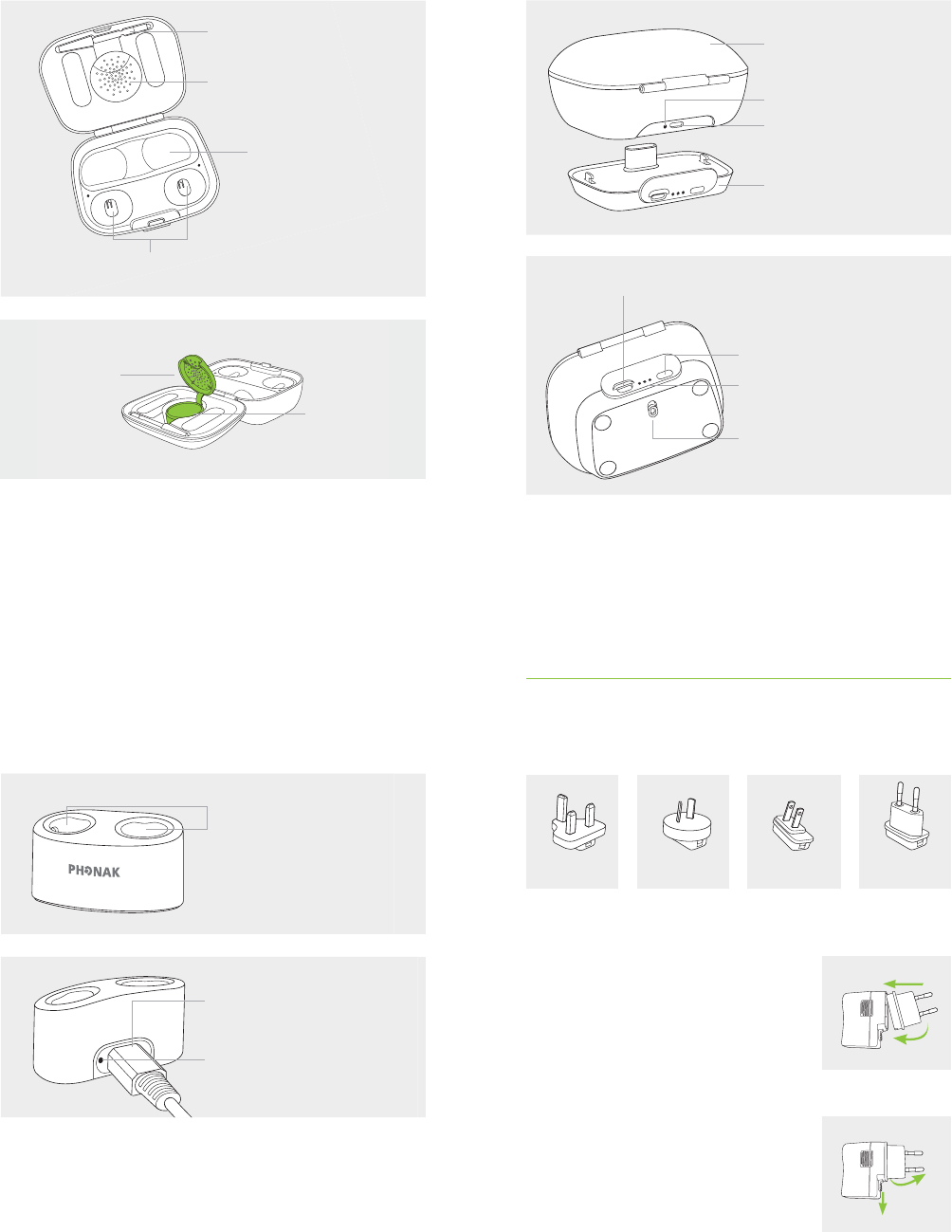
9
Space for earpieces
Cleaning tool
Space for drying
capsule (cover open)
Drying capsule
(optional)
Hearing aid charging inserts with left/right indicators
Space for drying capsule
(cover closed)
Charger Case
10
Charger Case with optional Power Pack
Charger Case
Indicator light for power
micro-USB connection
to external power supply
micro-USB connection to external power supply
Power Pack
Indicator light for battery status
and external power
Battery check button
Power Pack lock and release
11
Mini Charger
Hearing aid charging inserts
with left/right indicators
micro-USB connection
to external power supply
Indicator light for power
12
3. Preparing the charger
Select the adapter for your country.
a) Firstly, insert the top round end of
the adapter into the corresponding
round side of the power supply.
b) Click the bottom end of the adapter
to lock into place.
c) To remove, rst pull back the tab on
the power supply.
d) Pull the adapter upwards to remove
it.
3.1 Setting up the power supply
UK AUS US EU
a
b
cd
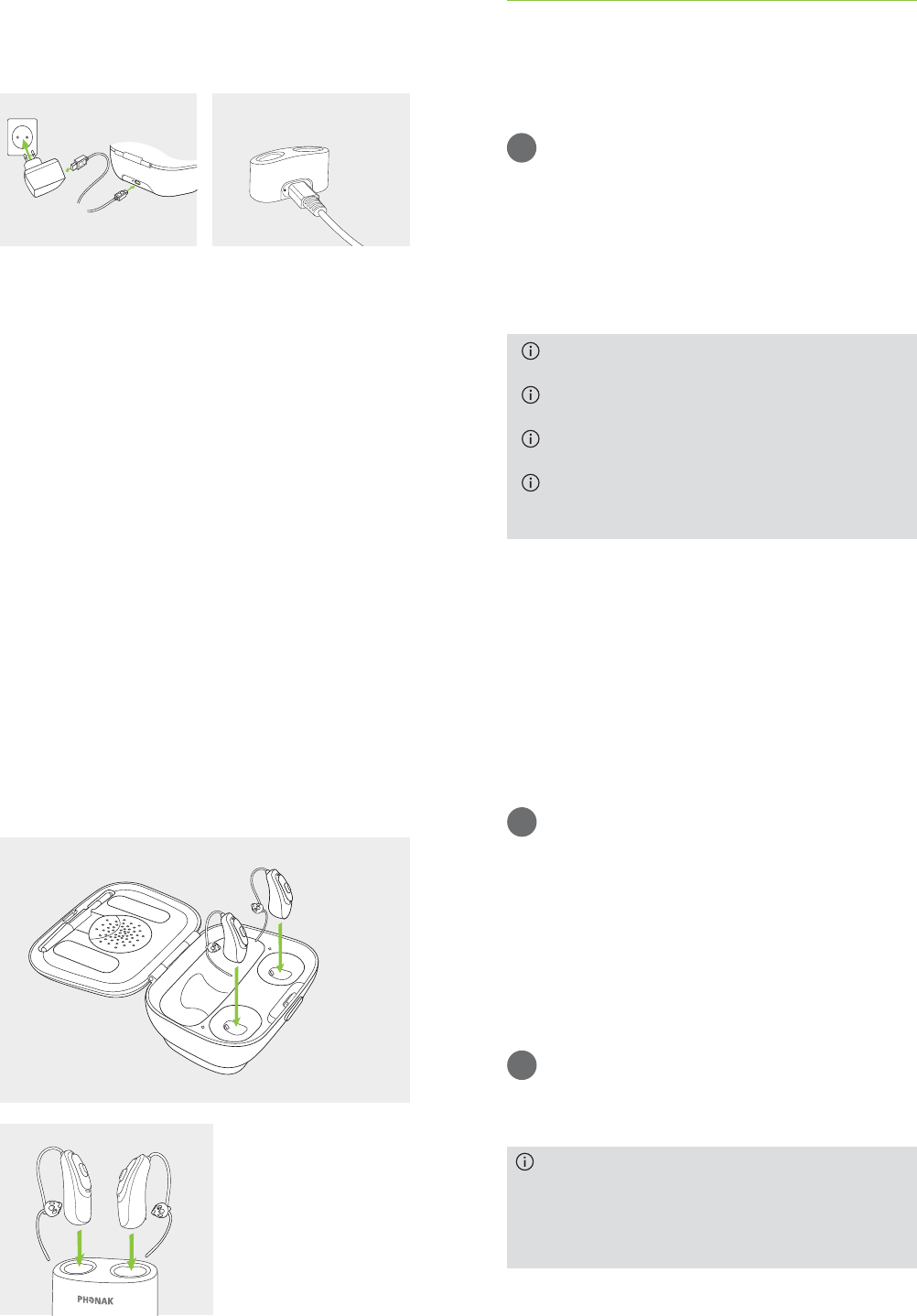
13
a) Plug the larger end of the charging cable into the power
supply.
b) Plug the smaller end into the micro-USB port on the
charger.
c) Plug the power supply into a power outlet.
d) The indicator light is green when the charger
is connected to the power supply.
3.2 Connecting the power supply
a
b
d
c
14
4.1 Using the Charger Case or Mini Charger
1
Please refer to chapter 6 for how to set up the charger.
Insert the hearing aid into the charging inserts.
Make sure the left and right hearing aid markings match
the left (blue)/right (red) indicators next to the charging
inserts. The hearing aids will automatically switch o
when inserted into the charger.
Audéo V-R contains a built-in and non-removable
rechargeable lithium-ion battery.
Before using Audéo V-R for the rst time, it is
recommended to charge it for 3 hours.
The hearing aid must be dry before charging,
see chapter 10.
Please ensure to charge and use the hearing aid
within operating temperature range: 0° to +40°
Celsius (32° to 104° Fahrenheit).
4. Charging the hearing aids
15 16
2
3
The indicator light will slowly blink until the hearing aid
is fully charged. When fully charged the indicator light
will remain on, i.e. solid green light.
The charging process will automatically stop when the
batteries are fully charged, so the hearing aids can be
safely left in the charger. It can take up to 3 hours to
charge the hearing aids. The Charger Case cover can be
closed while charging.
Remove the hearing aids from the charging inserts and
switch them on, refer to chapter 7.
Audéo V-R charging times
100% charge: 3 h
80% charge: 90 min
50% charge: 60 min
30% charge: 30 min
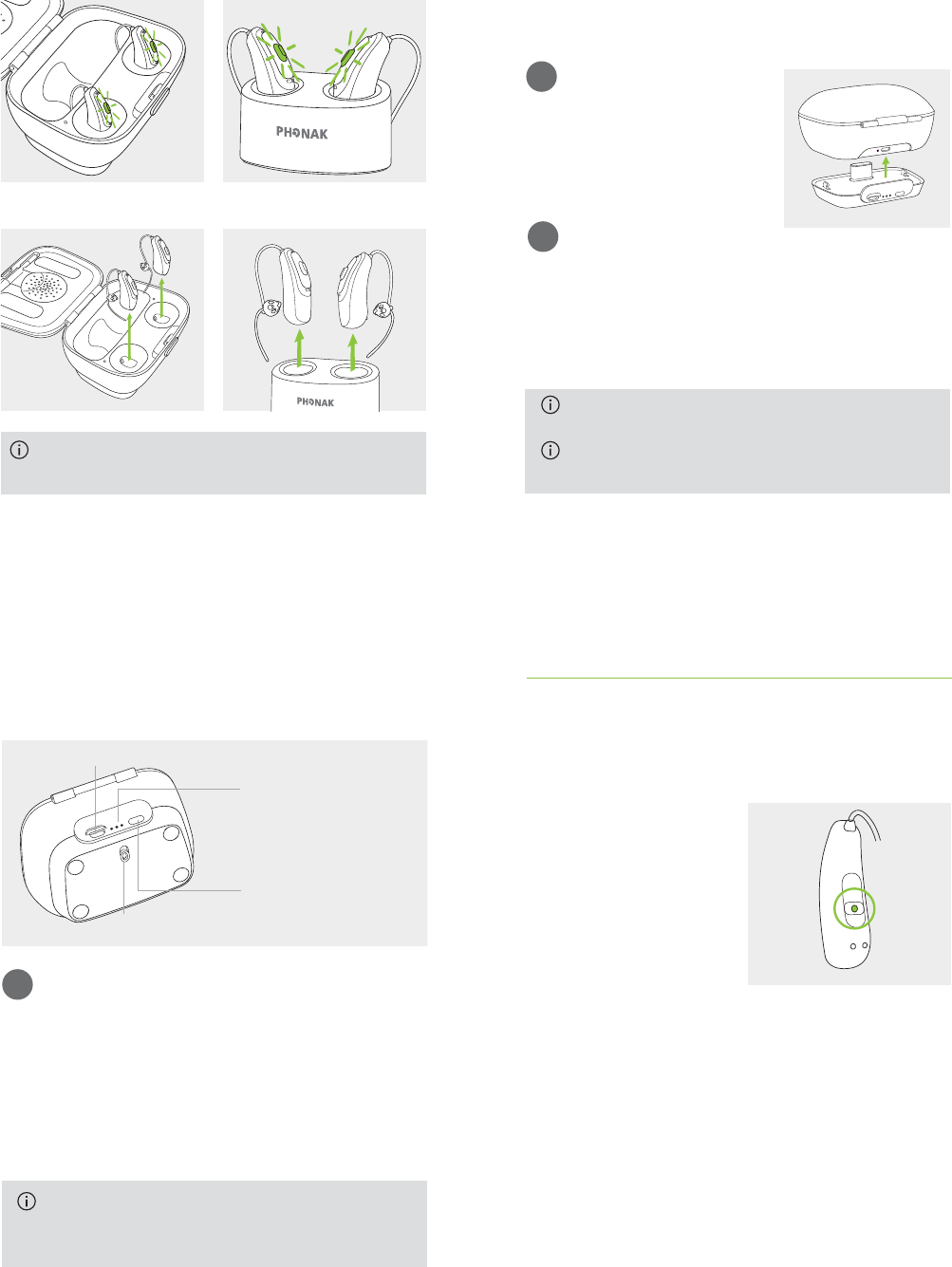
17
Do not hold the tubes for removing the hearing aids
from the charger as this can damage the xReceiver.
18
4.2 Using the optional Power Pack
Note: The Power Pack is only compatible with the Charger Case.
1
Attach and lock the Power Pack
to the Charger Case.
2
Plug in the micro-USB and connect to an external power
supply. The Power Pack and hearing aids will be charged at
the same time. While connected to an external power
supply, the Power Pack indicator light will show the
current battery charge status.
Before using Power Pack for the rst time, it is
recommended to charge it for 3 hours.
The Power Pack contains a built-in and non-
removable rechargeable lithium-polymer battery.
19
3
The fully charged Power Pack oers 7 charging cycles for
a pair of hearing aids. To check the remaining battery
capacity of the Power Pack, press the battery check push
button (indicator lights will be o otherwise, to preserve
battery).
Power Pack lock and release
Indicator light battery
status:
• 0%-29%
•• 30%-59%
••• 60%-100%
micro-USB connection to external power source
Battery check push button
Please ensure to charge the Power Pack within
operating temperature range: 0° to +40° Celsius
(32° to 104° Fahrenheit)
20
5. Left & right hearing aid markings
There is a red or blue marking on the back of the hearing
aid. This will tell you if it is a left or a right hearing aid.
Blue marking
for left hearing aid.
Red marking
for right hearing aid.
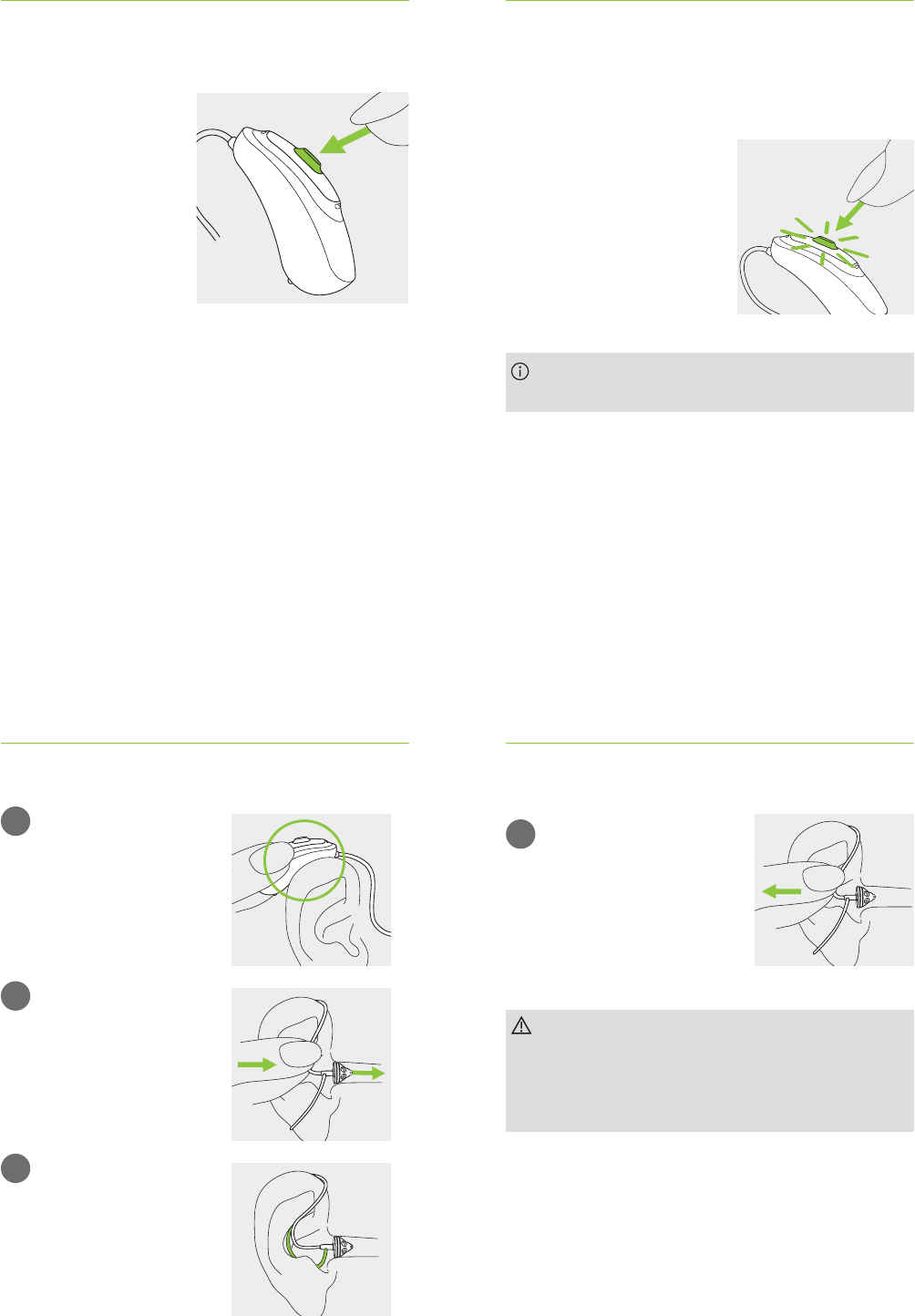
21
6. Push button
The push button on your
hearing aid can have
various functions or is
not active. This depends
on the programming of
the hearing aid, which is
indicated in your
individual “Hearing aid
instructions”. Please ask
your hearing care
professional for a
printout.
The push button has two functions:
Short push
Long push (3 seconds)
The push button is used to switch the hearing aid on and
o, refer to next chapter.
22
One short blink =
hearing aid turns on
Two short blinks =
hearing aid turns o
7. On/O
To switch the hearing aid on or o rmly press the button
using the tip of your nger for 3 seconds until the
indicator light blinks.
When you switch on the hearing aid you may hear a
start-up melody.
23
8. Putting on the hearing aid
1
2
3
Place the hearing aid behind
your ear.
Insert the earpiece into your
ear canal.
If there is an anchor attached
to the earpiece, tuck it into
the bowl of your ear to secure
your hearing aid.
24
9. Removing the hearing aid
1
Pull on the bend of the tube
and remove the hearing aid
from behind the ear.
In very rare cases, your earpiece can remain in your
ear canal when removing the hearing aid from the
ear. In the unlikely case that the earpiece does get
stuck in your ear canal, it is strongly recommended
to see a medical specialist for safe removal.
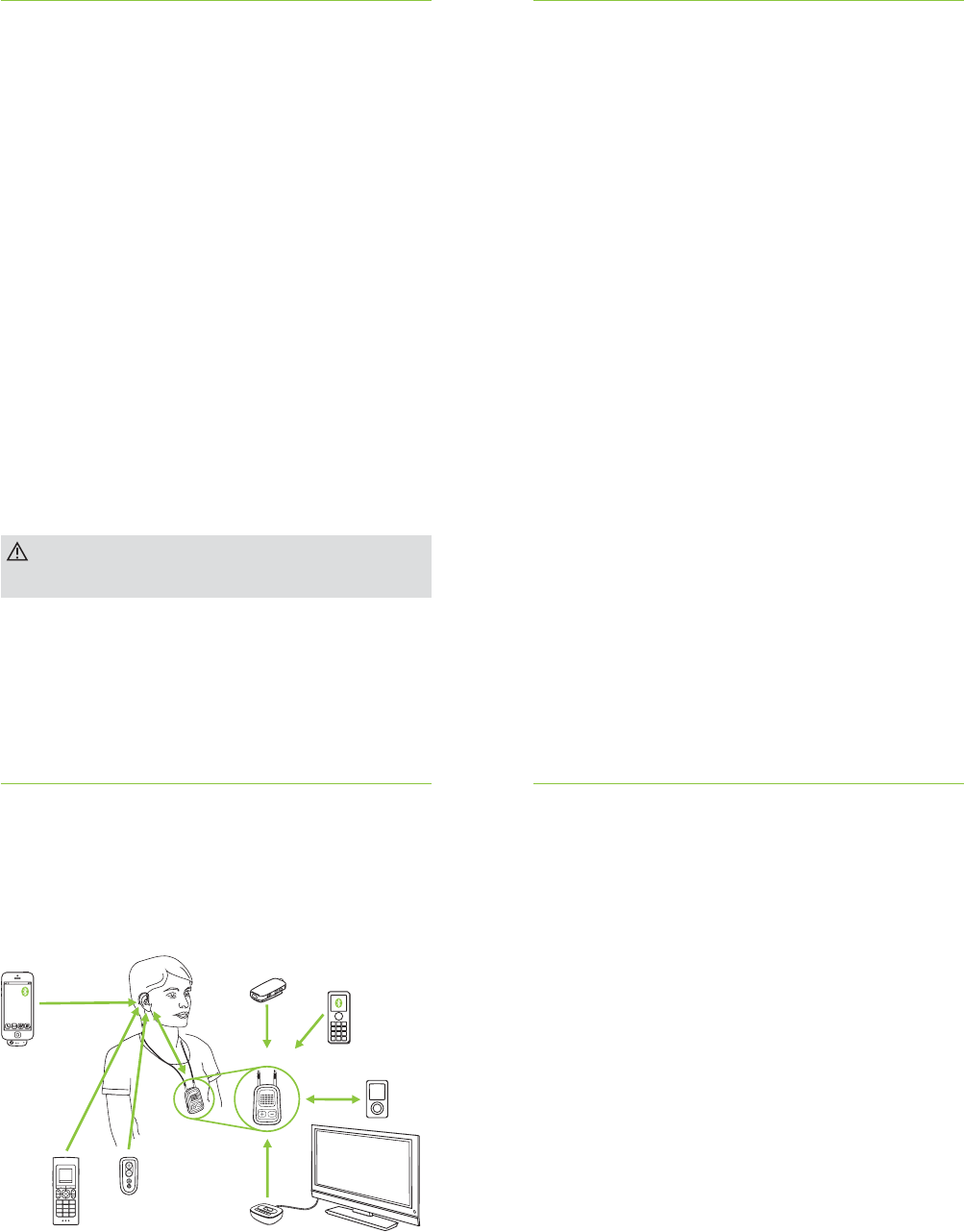
25
10. Care and maintenance
Diligent and routine care of your hearing aid and chargers
contribute to outstanding performance and a long service
life.
Please use the following specications as a guideline.
Further information regarding product safety, see
chapter 16.
General information
Before using hair spray or applying cosmetics, you should
remove your hearing aid from your ear, because these
products may damage it.
Your hearing aids are resistant to water, sweat and dust
under the following conditions:
• After exposure to water, sweat or dust, the hearing aid
is cleaned and dried.
• The hearing aid is used and maintained as described in
this user guide.
Always make sure that the hearing aids and
charger are dry and clean before charging.
26
Daily
Hearing aid: Inspect the earpiece for earwax and
moisture deposits. Clean the surfaces with a lint-free
cloth or use the small brush provided in the Charger Case.
Never use cleaning agents such as household detergents,
soap, etc. for cleaning your hearing aid. It is not
recommended to rinse with water. If you need to clean
your hearing aid intensively, ask your hearing care
professional for advice and information on lters or
drying capsules.
Chargers: Make sure that charger inserts are clean.
Never use cleaning agents such as household detergents,
soap, etc. for cleaning your charger.
Weekly
Hearing aid: Clean the earpiece with a soft, damp cloth
or with a special cleaning cloth for hearing aids. For more
in-depth maintenance instructions or for more than basic
cleaning, please see your hearing care professional. Clean
the charging contacts on the hearing aid with a soft,
damp cloth.
Chargers: Remove dust or dirt from the charger inserts.
27
11. Wireless accessories
A range of Phonak wireless accessories are available for
you to use with your hearing aid.
* The Phonak ComPilot II with neckloop or ComPilot Air II with clip to attach to clothing. They
also have basic remote control functionalities. For advanced control they can be used with the
Phonak RemoteControl App.
** Audio sources (e.g. MP3 Player, computer, laptop, tablet) can be connected to the streaming
device via Bluetooth or audio cable.
*** Clipped onto the speaker’s clothing for better understanding over distance.
Cell phone
Phonak streaming device*
Phonak EasyCall II
with cell phone
Phonak RemoteMic***
MP3 Player/
Audio source**
Phonak TVLink II connected to TV
Phonak PilotOne II
remote control
Phonak DECT phone II
28
12. Service and warranty
Local warranty
Please ask the hearing care professional, where you
purchased your hearing aid and chargers, about the
terms of the local warranty.
International warranty
Phonak oers a one year limited international
warranty, valid starting from the date of purchase.
This limited warranty covers manufacturing and
material defects in the hearing aid and chargers
respectively, but not accessories such as tubes,
earmolds, external receivers. The warranty only
comes into force if a proof of purchase is shown.
The international warranty does not aect any legal
rights that you might have under applicable national
legislation governing sale of consumer goods.
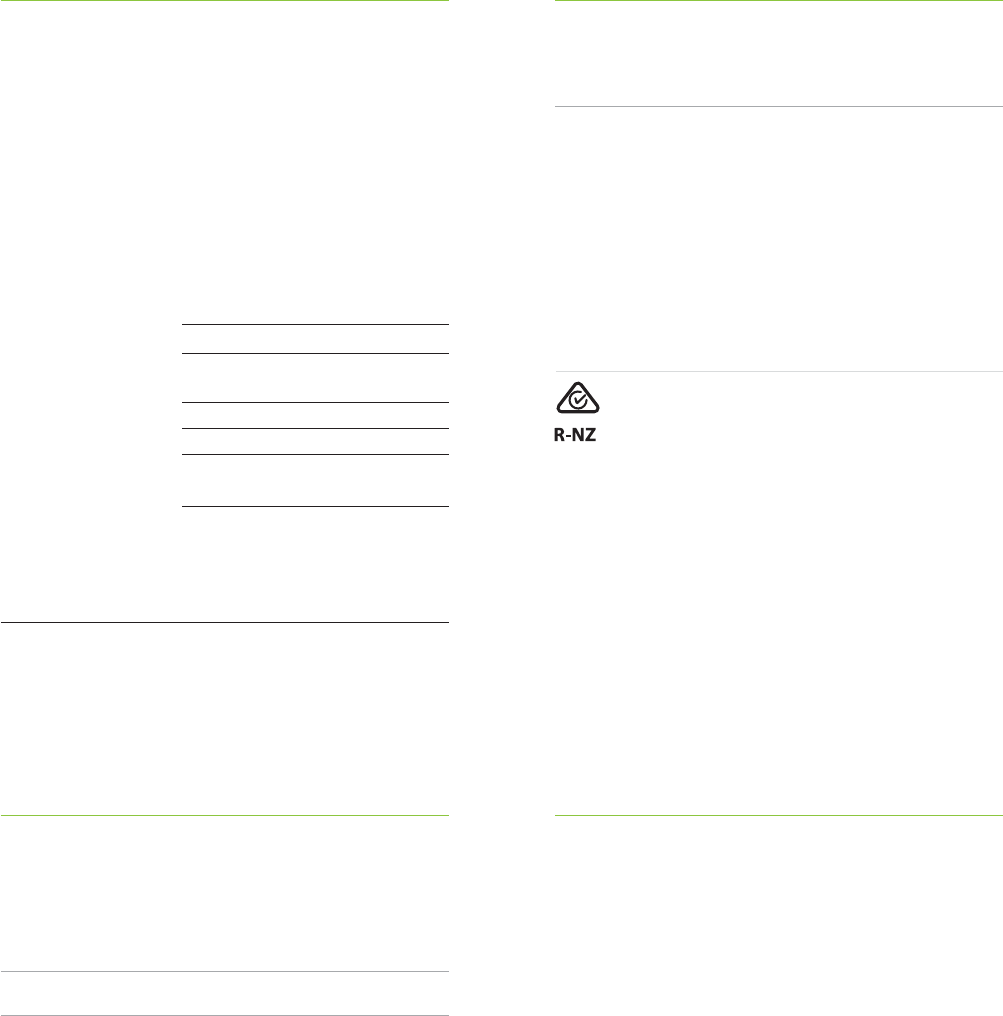
29
Warranty limitation
This warranty does not cover damage from improper
handling or care, exposure to chemicals or undue stress.
Damage caused by third parties or non-authorized service
centers renders the warranty null and void. This warranty
does not include any services performed by a hearing care
professional in their oce.
Serial numbers
Hearing aid left side:
Hearing aid right side:
Charger Case:
Power Pack:
Mini Charger:
Date of purchase:
Authorized hearing care
professional (stamp/signature):
30
Europe:
Declaration of Conformity for the hearing aid
Hereby Phonak AG declares that this Phonak product
meets the requirements of the Medical Devices Directive
93/42/EEC as well as the Radio and Telecommunications
Terminal Equipment Directive 1999/5/EC. The full text of
the Declaration of Conformity can be obtained from the
manufacturer or the local Phonak representative whose
address can be taken from the list on www.phonak.com
(Phonak worldwide locations).
Australia/New Zealand:
Indicates a device’s compliance with applicable
Radio Spectrum Management’s (RSM) and
Australian Communications and Media Authority
(ACMA) regulatory arrangements for the legal
sale in New Zealand and Australia.
The compliance label R-NZ is for radio products
supplied in the New Zealand market under
conformity level A1.
13. Compliance information
31
The wireless models listed on page 3 are certied under:
Phonak Audéo V90-R
USA FCC ID: KWC-RICR
Canada IC: 2262-RICR
32
Notice 1:
This device complies with Part 15 of the FCC Rules and
with RSS-210 of Industry Canada. Operation is subject to
the following two conditions:
1) this device may not cause harmful interference, and
2) this device must accept any interference received,
including interference that may cause undesired operation.
Notice 2:
Changes or modications made to this device not
expressly approved by Phonak may void the FCC
authorization to operate this device.
Notice 3:
This device has been tested and found to comply with
the limits for a Class B digital device, pursuant to Part 15
of the FCC Rules and ICES-003 of Industry Canada.
These limits are designed to provide reasonable protection
against harmful interference in a residential installation.
This device generates, uses and can radiate radio
frequency energy and, if not installed and used in
accordance with the instructions, may cause harmful
interference to radio communications. However, there is
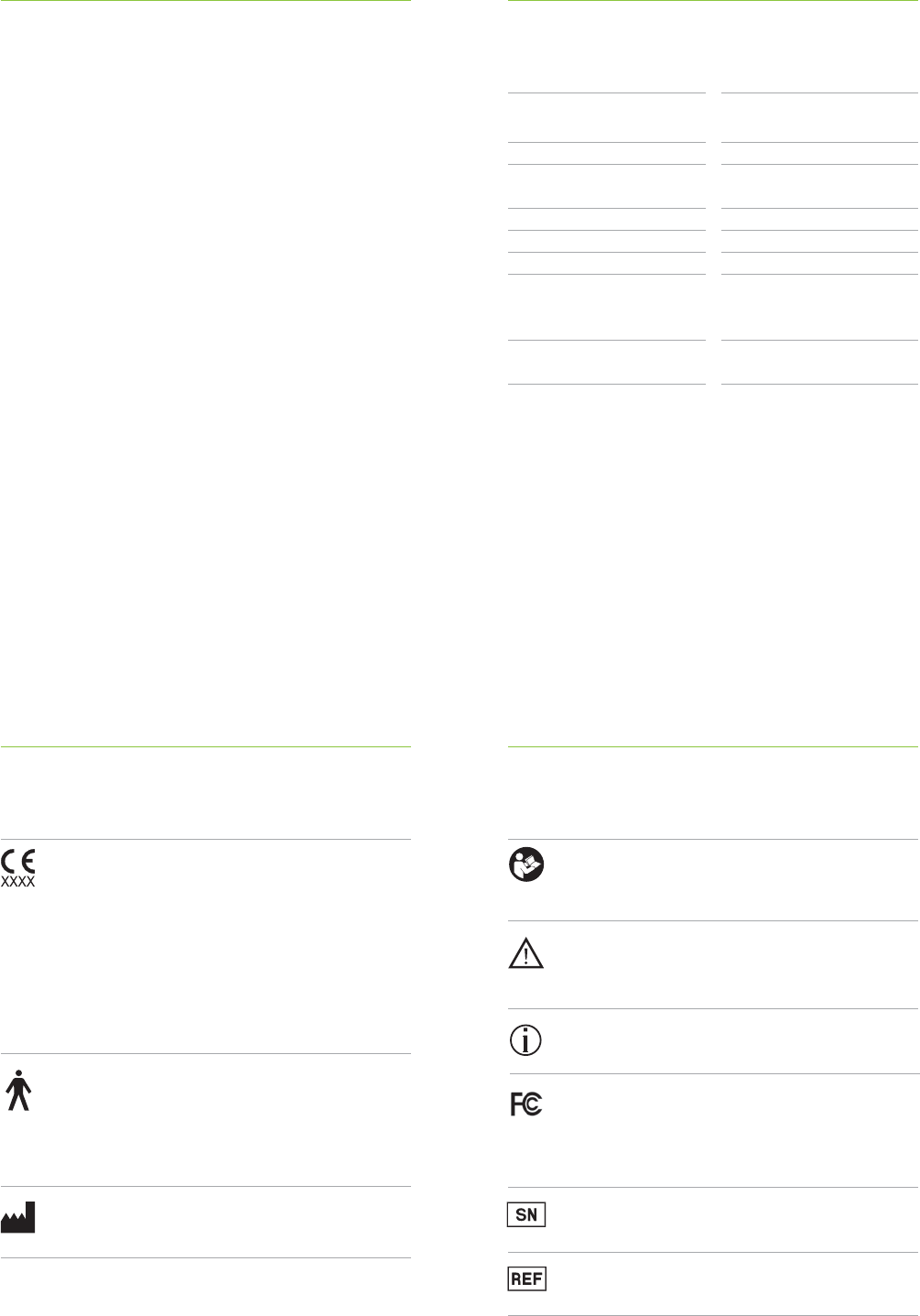
33
no guarantee that interference will not occur in a
particular installation. If this device does cause harmful
interference to radio or television reception, which can be
determined by turning the equipment o and on, the user
is encouraged to try to correct the interference by one or
more of the following measures:
• Reorient or relocate the receiving antenna.
• Increase the separation between the device
and receiver.
• Connect the device into an outlet on a circuit
dierent from that to which the receiver is connected.
• Consult the dealer or an experienced radio/TV
technician for help.
34
Antenna type
Operation frequency
Occupied bandwidth
(99% BW)
Modulation
Channel
Operating range
Use case
Magnetic eld strength
@ 1m
Integrated ferrite coil
antenna (inductive)
10.6 MHz
498 kHz
DQPSK
Single channel radio
18 cm (7”)
Streaming of audio signal to
receiving hearing aid on the
other ear
-4 dBμA/m
Radio information of your wireless hearing aid
35
With the CE symbol, Phonak AG conrms that
this Phonak product – including accessories
– meets the requirements of the Medical
Devices Directive 93/42/EEC as well as the
R&TTE Directive 1999/5/EC on radio and
telecommunications equipment. The numbers
after the CE symbol correspond to the code of
certied institutions that were consulted under
the above-mentioned directives.
This symbol indicates that the products
described in these user instructions adhere to
the requirements for an applied part of Type B
of EN 60601-1. The surface of the hearing aid is
specied as an applied part of Type B.
Indicates the medical device manufacturer, as
dened in EU Directive 93/42/EEC.
14. Information and description
of symbols
36
This symbol indicates that it is important for
the user to read and take into account the
relevant information in these user guides.
This symbol indicates that it is important for
the user to pay attention to the relevant
warning notices in these user guides.
Important information for handling and
product safety.
This symbol confers that the electromagnetic
interference from the device is under limits
approved by the US Federal Communications
Commission.
Indicates the manufacturer’s serial number so
that a specic medical device can be identied.
Indicates the manufacturer’s catalogue number
so that the medical device can be identied.
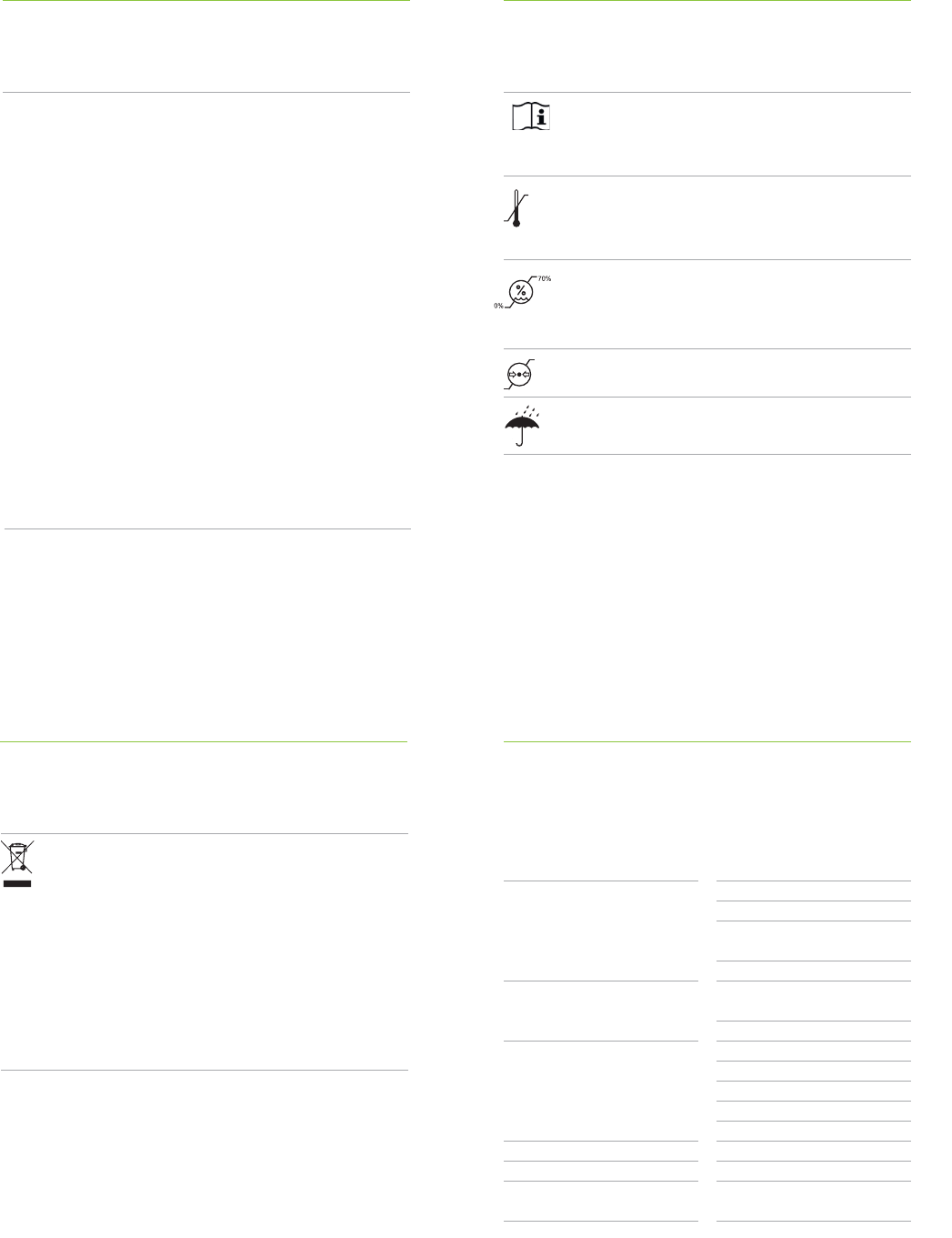
37
The product is designed such that it functions
without problems or restrictions if used as
intended, unless otherwise noted in these
user guides.
Please ensure to charge the hearing aid and
Power Pack within operating temperature
range: 0° to +40° Celsius (32° to 104°
Fahrenheit).
Audéo V-R are classied IP68 (depth of 1 meter
for 60 minutes) and designed to be used in all
daily life situations. Therefore you do not have
to worry about getting the hearing aids exposed
to a rain shower or sweat. However, Audéo V-R
is not intended to be used in water activities
that includes chlorinated water, soap, salt water
or other liquids with a chemical content.
Humidity during operation for the Charger
Case, Mini Charger and Power Pack: : 0% to
85% (non condensing).
Operating
conditions
38
This symbol indicates that it is important for
the user to read and take into account the
relevant information in this user guide.
Temperature during transportation
and storage: –20° to +60° Celsius
(–4° to +140° Fahrenheit).
Humidity during storage: 0% to 70%, if not in
use. See instruction in chapter 16.2 regarding
drying the hearing aid after use.
Atmospheric pressure: 200 hPA to 1500 hPa
During transportation keep dry.
39
The symbol with the crossed-out garbage bin
is to make you aware that this hearing aid as
well as chargers and Power Pack may not be
thrown away as normal household waste.
Please dispose of old or unused hearing aids
and charger, at waste disposal sites intended
for electronic waste, or give your hearing aid
to your hearing care professional for disposal.
Proper disposal protects the environment and
health.
40
15. Troubleshooting
Causes
Blocked speaker/earpiece
Hearing aid switched o
Electromagnetic disturbances
occurred
Battery fully discharged
Hearing aid not inserted correctly
into ear
Cerumen in ear canal
Volume too loud
Low battery
Speaker/earpiece blocked
Volume too low
Hearing has changed
Indication for low battery
Battery fully discharged
Faulty battery
Problem
Hearing aid not functioning
Hearing aid whistles
Hearing aid not loud enough
or distorted
Hearing aid plays two beeps
Hearing aid will not start up
Indicator light on hearing aid
blinks fast while charging
15.1 Troubleshooting hearing aid
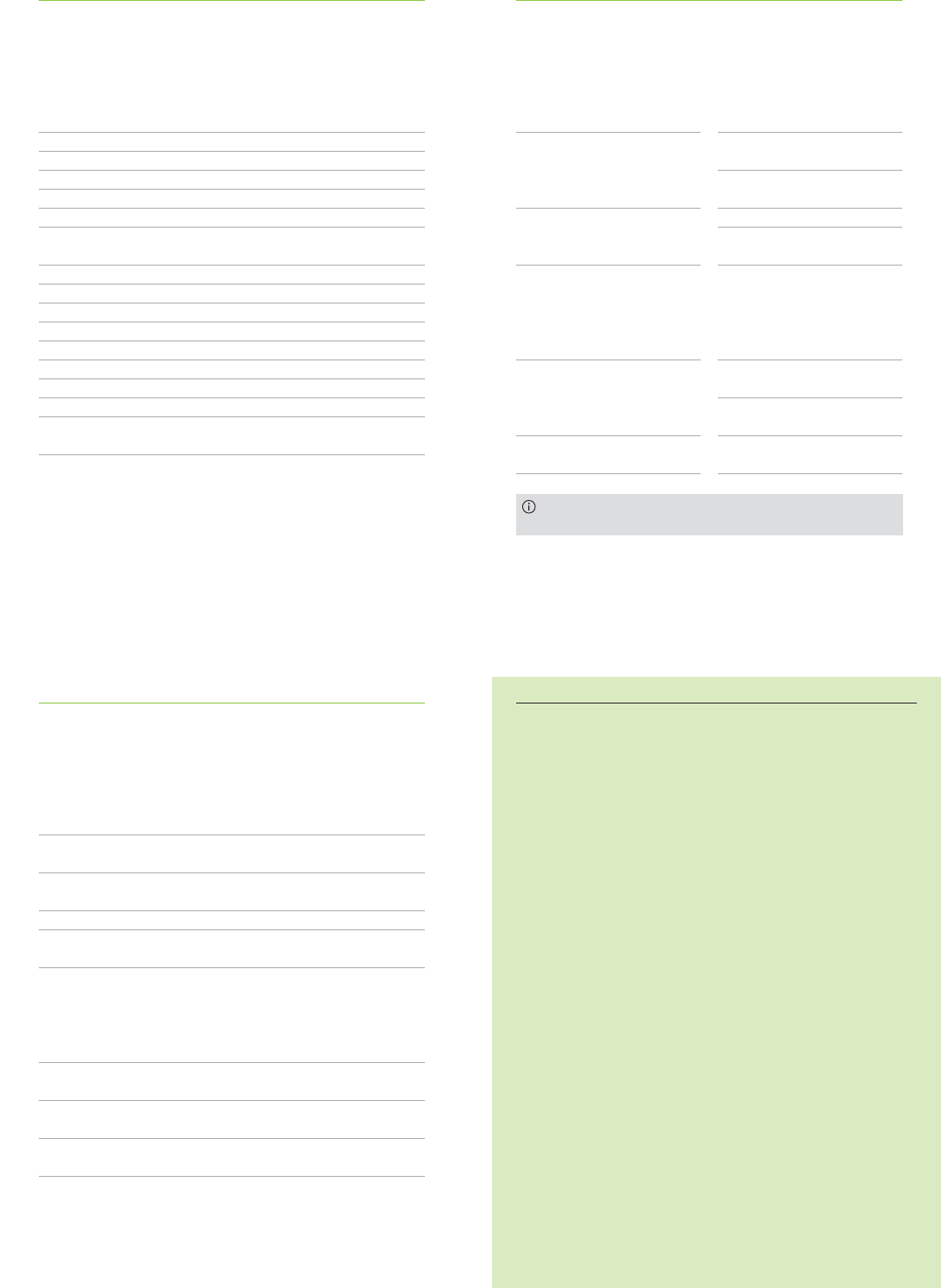
41
What to do
Clean speaker opening/earpiece
Press push button for 3 seconds (chapter 1+7)
Press push button
Insert hearing aid into the charger
Charge hearing aid (chapter 4)
Insert hearing aid correctly (chapter 8)
Contact your ENT/GP or hearing care professional
Decrease volume (chapter 6)
Charge hearing aid (chapter 4)
Clean speaker opening/earpiece
Turn volume up if volume control available (chapter 6)
Contact you hearing care professional
Charge hearing aid (chapter 4)
Charge hearing aid (chapter 4)
Contact your hearing care professional if the battery life is not as
expected
42
If the problem persists, contact you hearing care professional for
assistance.
Causes
Hearing aid not inserted correctly
into charger
Charger not connected to power
source
Hearing aid is not fully charged
Battery may need to be replaced
Causes
Charger Case or Mini Charger is
not connected to power supply
Hearing aid not inserted correctly
into charger
Power Pack discharged
Problem
The indicator light on the hearing
aid is o when placed in the
charging inserts
Battery does not last the whole
day
Problem
Charging does not start (no power
pack used)
Charging does not start when
using Power Pack
15.2 Troubleshooting charger
43
What to do
Insert hearing aid correctly into charger (chapter 4)
Connect charger to external power supply
Charge hearing aid (chapter 4)
Contact your hearing care professional; a battery replacement may be
required
What to do
Connect charger to power fully or power pack (see section 4.2)
Insert hearing aid correctly into charger (chapter 4.1)
Charge Power Pack (chapter 4.2)
44
Please read the information on the following pages before
using your hearing aid and charging accessories.
A hearing aid will not restore normal hearing and will not
prevent or improve a hearing impairment resulting from
organic conditions. Infrequent use of a hearing aid does not
permit a user to attain full benet from it. The use of a
hearing aid is only part of hearing habilitation and may
need to be supplemented by auditory training and
instruction in lipreading.
The hearing aid is suitable for the home healthcare
environment and due to their portability it may happen that
it is used in professional healthcare facility environment like
physician oces, dental oces etc.
16. Important safety information
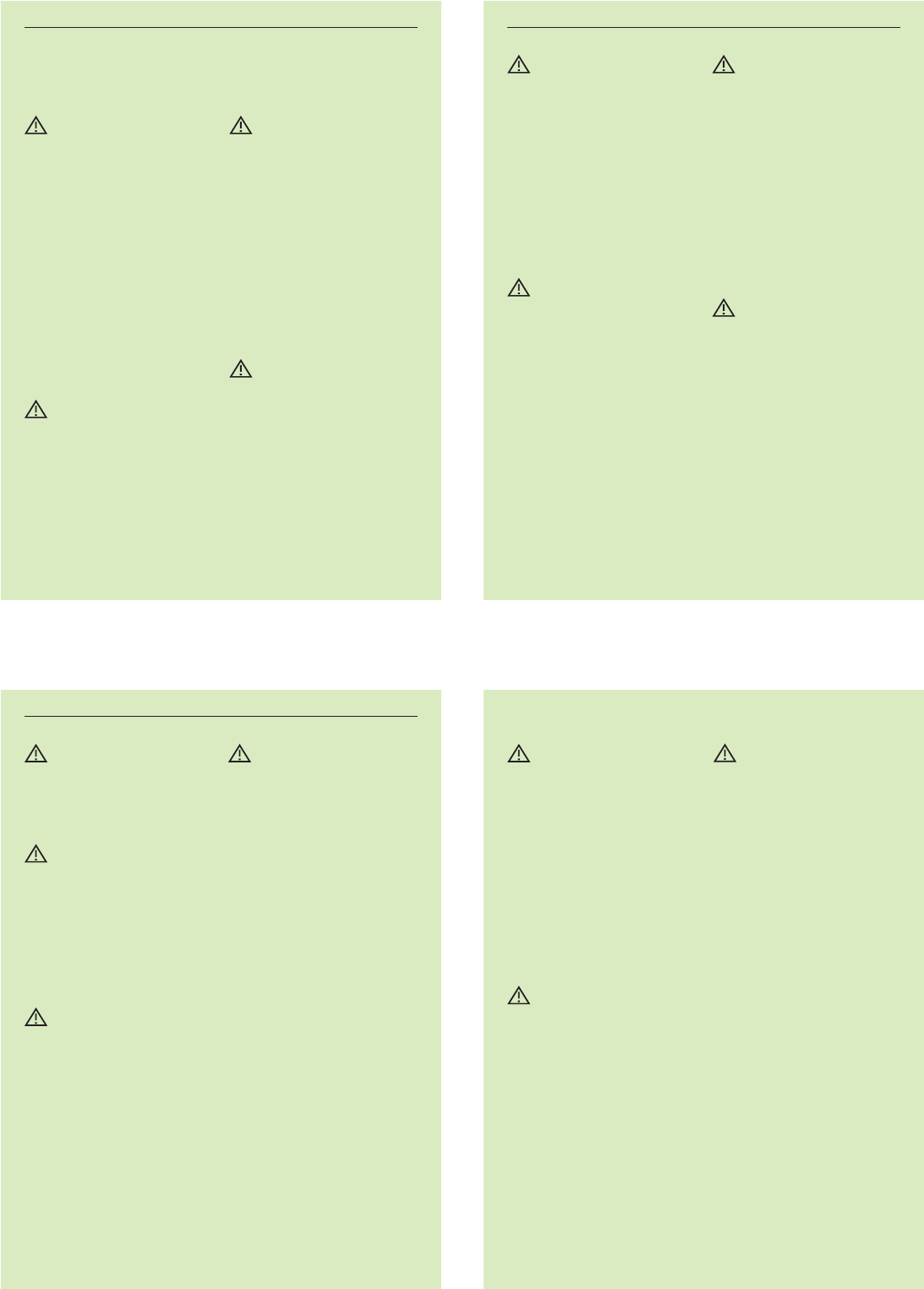
45
The intended use of
hearing aids is to amplify
and transmit sound to the
ears and hereby
compensate for impaired
hearing. The hearing aids
(specially programmed for
each hearing loss) must
only be used by the
intended person. They
should not be used by any
other person as they could
damage hearing.
Changes or modications
to the hearing aid that
were not explicitly
approved by Phonak are
not permitted. Such
changes may damage your
ear or the hearing aid.
Do not use the hearing
aids and charging
accessories in explosive
areas (mines or industrial
areas with danger of
explosions, oxygen rich
environments or areas
where ammable
anesthetics are handled) or
where electronic
equipment is prohibited.
If you feel pain in or
behind your ear, if it is
inamed or if skin irritation
and accelerated
accumulations of earwax
occur, please check with
your hearing care
professional or physician.
16.1 Hazard warnings
46
In very rare cases, the
dome can remain in your
ear canal when removing
the hearing tube from the
ear. In the unlikely case
that the dome does get
stuck in your ear canal, it is
strongly recommended to
see a physician for safe
removal.
Hearing programs in the
directional microphone
mode reduce background
noises. Please be aware
that warning signals or
noises coming from
behind, e. g. cars, are
partially or entirely
suppressed.
This hearing aid is not for
children below 36 months.
It contains small parts that
can cause choking, if
swallowed by children.
Keep out of reach of
children and mentally
challenged people or pets.
If swallowed, consult a
physician or hospital
immediately.
Keep the Charger Case out
of reach of children and
mentally challenged people
or pets. If the drying
capsule is swallowed,
consult a physician or
hospital immediately.
47
•
•
Only authorized personnel
are allowed to open the
Power Pack due to possible
electrical hazard.
Do not make a wire
connection from your
hearing aid to any external
audio sources like radio
etc. That could cause
injuries on your body
(electric shock).
Do not cover the whole
Charger Case or Mini
Charger while charging,
e.g. with a cloth etc.
The following is only
applicable for persons with
active implantable medical
devices (i.e. pacemakers,
debrillators, etc.):
Keep the wireless hearing
aid at least 15 cm
(6 inches) away from the
active implant. If you
experience any interference,
do not use the wireless
hearing aids and contact
the manufacturer of the
active implant. Please, note
that interference can also
be caused by power lines,
electrostatic discharge,
airport metal detectors etc.
Keep magnets (i.e.
EasyPhone magnet, etc.)
at least 15 cm (6 inches)
away from the active
implant.
48
Use of this equipment
adjacent to or stacked with
other equipment should be
avoided because it could
result in improper
operation. If such use is
necessary, this equipment
and the other equipment
should be observed to
verify that they are
operating normally.
Use of accessories,
transducers and cables
other than those specied
or provided by the
manufacturer of this
equipment could result in
increased electromagnetic
emissions or decreased
electromagnetic immunity
of this equipment and
result in improper
operation.
Portable RF
communications
equipment (including
peripherals such as
antenna cables and
external antennas) should
be used no closer than
30 cm (12 inches) to any
part of the Audéo V-R,
including cables specied
by the manufacturer.
Otherwise, degradation of
the performance of this
equipment could result.
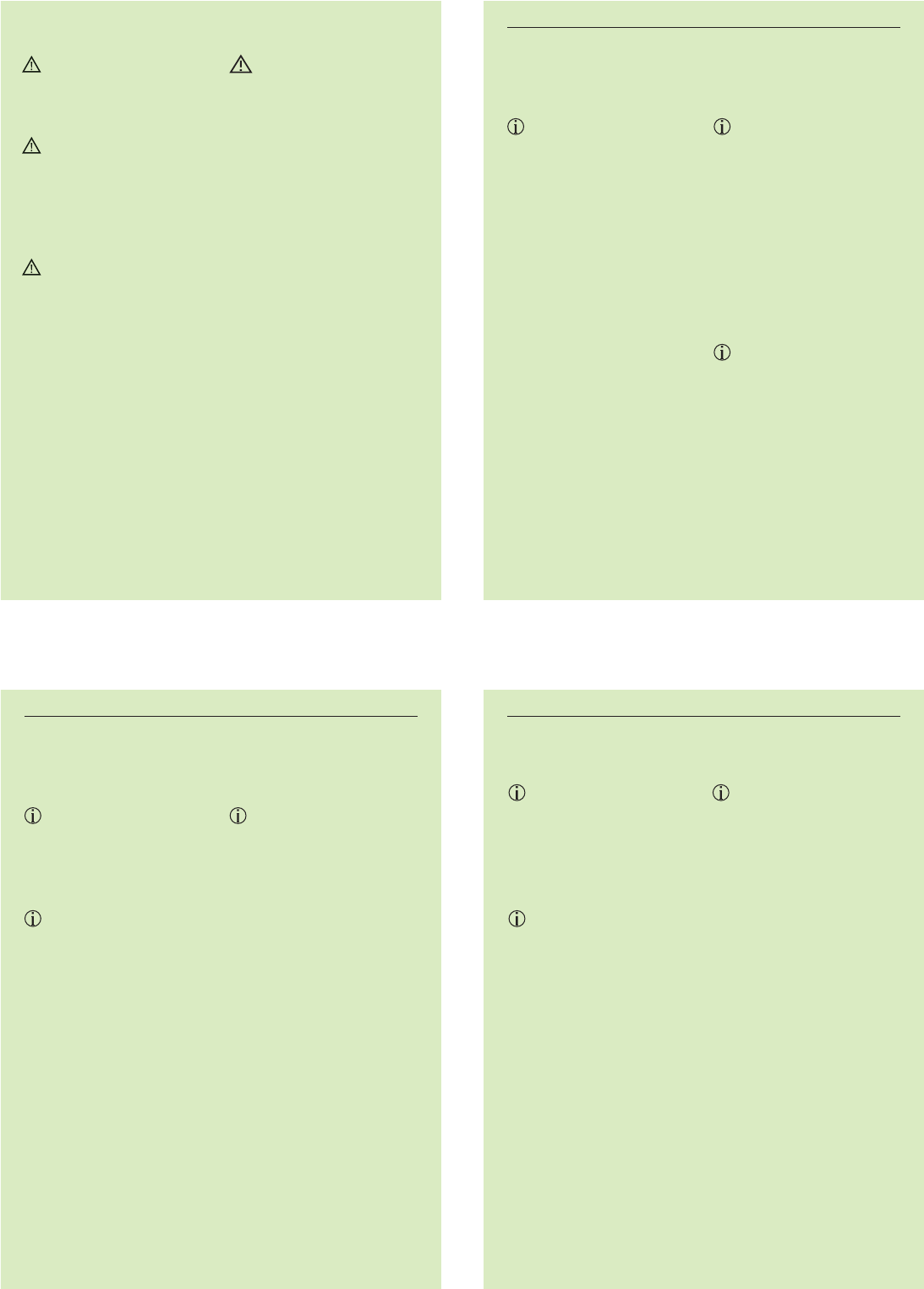
49
Hearing aids should not be
tted with domes / wax
protection systems when
used by clients with
perforated eardrums,
inamed ear canals or
otherwise exposed middle
ear cavities. In these cases,
we recommend the use of
a custom earpiece.
In the unlikely case that
any part of this product
should remain in the ear
canal, it is strongly
recommended to see a
medical specialist for safe
removal.
The USB port of the
charger is to be used for
the described purpose only.
For charger, use only
EN60950-certied
equipment with a output
rating of 5 VDC.
Min. 500 mA.
Do not insert the adapter
of the power supply alone
into electrical outlets
because this could result in
an electric shock.
50
Phonak hearing aids are
water resistant and not
waterproof. They are
designed to withstand
normal activities and
occasional accidental
exposure to extreme
conditions. Never immerse
your hearing aid in water!
Phonak hearing aids are not
specically designed for
extended periods of water
submersion on a continual
basis, that is worn in
activities such as swimming
or bathing. Always remove
your hearing aid before
these activities, as the
hearing aid contains
sensitive electronic parts.
16.2 Information on product safety
Protect your hearing aid
from heat (never leave near
a window or in the car).
Never use a microwave or
other heating devices to
dry your hearing aid (due
to risk of re or explosion).
Ask your hearing care
professional about suitable
drying methods.
The dome should be
changed every three
months or when it
becomes sti or brittle.
This is to prevent the dome
from detaching from the
tube spout during insertion
into or removal from the
ear.
51
Do not drop your hearing
aid! Dropping onto a hard
surface can damage your
hearing aid.
Store you hearing aid in
the charger if you are not
using it for a long period
of time.
Special medical or dental
examination including
radiation described below,
may adversely aect the
correct functioning of your
hearing aids. Remove and
keep them outside the
examination room/area
before undergoing:
• Medical or dental
examination with X-ray
(also CT scan).
• Medical examinations with
MRI/NMRI scans, generating
magnetic elds.
Hearing aids don’t need to
be removed when passing
security gates (airports
etc.). If X-ray is used at all,
it will be in very low doses,
and will not aect the
hearing aids.
52
The hearing aids has to be
dry before charging.
Otherwise the charging
reliability cannot be
guaranteed.
Only use approved
chargers and Power Pack
described in this user guide
for charging Audéo V-R,
otherwise the devices may
be damaged.
Audéo V-R and Power Pack
contain lithium-ion
batteries tested according
to the UN 38.3 standard
and should be shipped
according to the rules and
regulations of safe
shipment of Lithium ion
batteries.
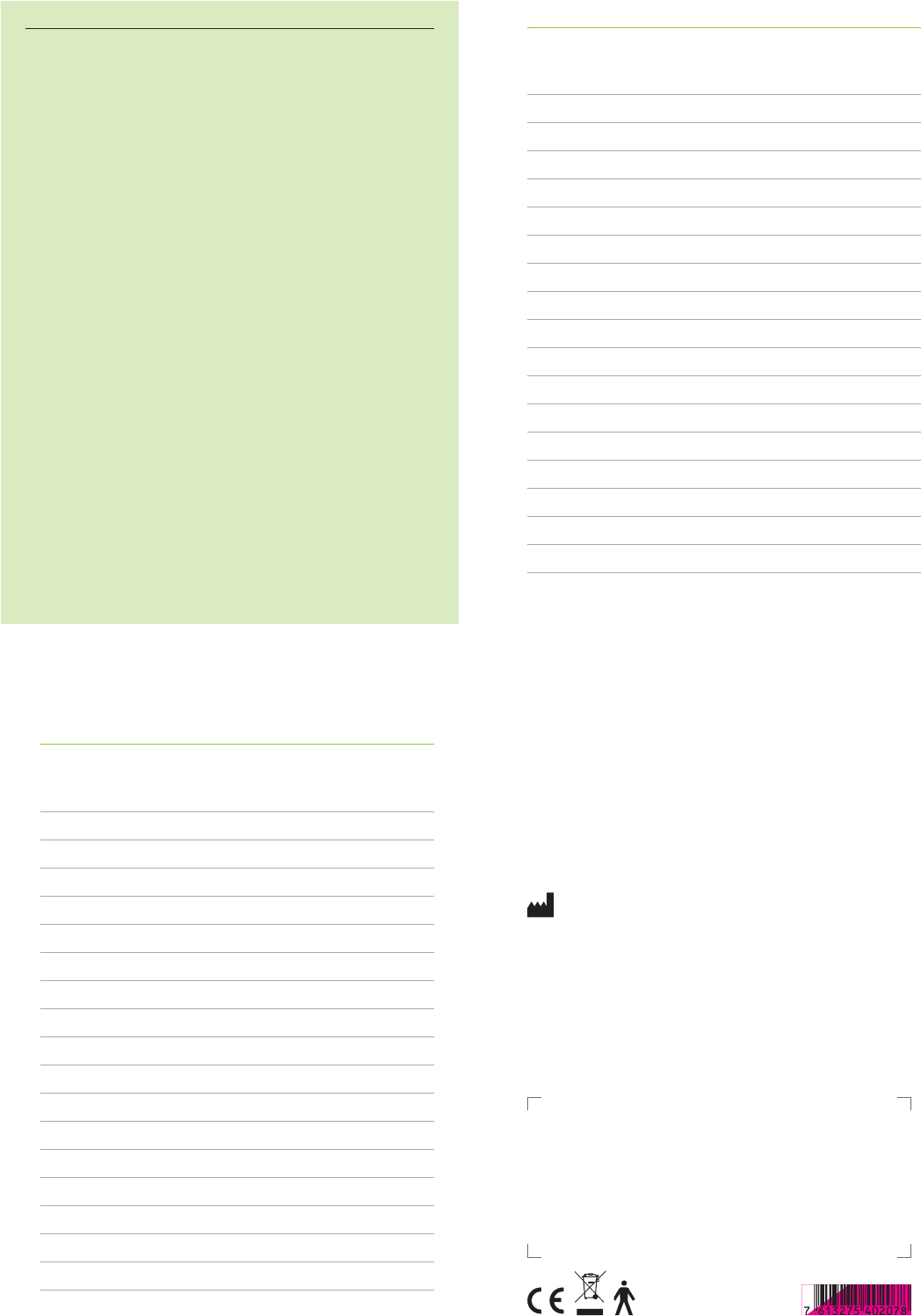
53 54
Notes
55
029-XXXX-02/V1.00/2016-02/na Printed in Switzerland © Sonova AG All rights reserved
Manufacturer:
Phonak AG
Laubisrütistrasse 28
CH-8712 Stäfa
Switzerland
Your hearing care professional: